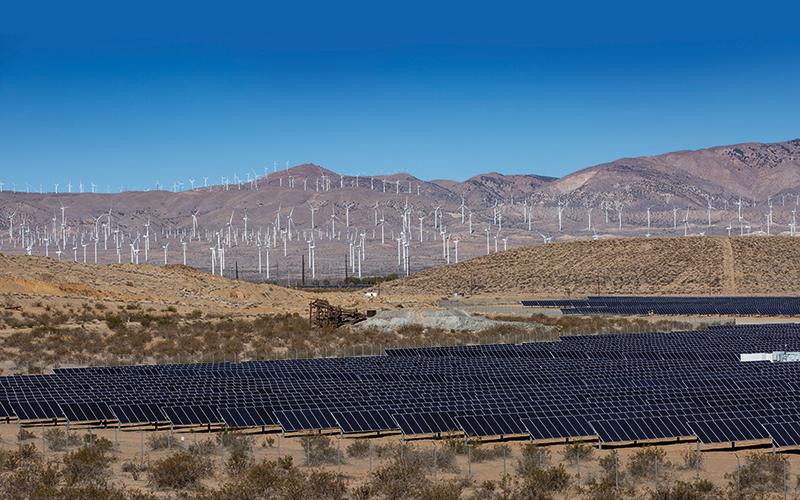Will America's new climate law supercharge clean energy development?
The US Inflation Reduction Act could triple the country’s solar and wind investments by 2030. But reaching full clean electricity deployment potential depends on state action, says Silvio Marcacci at Energy Innovation Policy & Technology LLC

The Inflation Reduction Act (IRA) of 2022 is the most significant clean energy legislation in US history. Using the central estimates of studies from Energy Innovation, Princeton University, Rhodium Group and Resources for the Future, independent modelling suggests IRA electricity sector provisions make a 73–76% clean electricity grid the lowest-cost pathway through to 2030. Achieving this level of clean electricity would roughly triple annual wind and solar capacity investments by 2030, adding 65–95GW of utility-scale wind and solar capacity annually through 2030.
This clean economic boom is already underway. Since the Bill’s passage in August 2022, new investments totalling US$90bn have been announced in 31 states, helping create more than 100,000 jobs. These investments include 12 new solar manufacturing facilities, representing a 300% increase in US solar module manufacturing capacity.
However, hitting high-end renewable energy deployment depends on the federal government implementing IRA provision, and uptake by states. Recurring renewal and lapse cycles of the US production tax credit (PTC) between 1998 and 2017 drove a wind industry boom-bust pattern of rapid growth followed by ceased construction among developers.
Clean energy tax credits could catalyse renewables deployment
The IRA provisions with the most significant clean energy impact fall into two buckets: tax credits and government-backed infrastructure financing.
Clean energy tax credits have historically been the most important federal climate policies, driving solar and wind resources from being niche to being the country’s fastest-growing energy technologies. The IRA updates these policies to provide long-term industry certainty and expedite the clean energy transition through financing for utilities and governments.
The IRA’s two key tax credits are the PTC, largely supporting wind energy, and the investment tax credit (ITC), primarily supporting solar. Before the IRA passage, the PTC had expired, and the ITC had started to be phased out for projects starting construction in 2022.
On the IRA’s passage, these tax credits changed in four crucial ways:
- The PTC and ITC were restored to their full values, starting with projects placed into service in 2022 and continuing for projects starting construction through either 2032 or the point at which the US Treasury determines that the electricity sector emits at least 75% fewer emissions than in 2022, whichever comes later. The credits then phase out to 75% value in the subsequent year and 50% in the year after that, before expiring completely.
- Solar projects put into service in 2022 or later may now elect the PTC instead of the ITC, which may be more lucrative as capital costs continue declining. Energy storage projects put into service starting in 2022 can also qualify for the ITC without having to be co-located with, and charge primarily from, solar resources.
- Full ITC and PTC credits depend upon projects meeting high-road labour standards. Both tax credits provide bonuses for projects that procure content from domestic sources and for projects located in “energy communities” that are affected by fossil fuel development or facility closures.
- The IRA diminishes roadblocks to credit uptake and increases credit effectiveness by changing the way tax credits are monetised. The PTC and ITC are now directly refundable – and thus accessible – to non-profit, tax-exempt entities such as rural electric cooperatives or tribal utilities. Tax credits are also now transferable for private developers and for-profit utilities, opening access to a larger pool of taxable entities for project financing.
Lighting the way without coal
IRA tax credit changes are just one of the catalysts for new investments. When the changes are combined with fast-falling clean energy prices, 99% of existing US coal plants are more expensive to run than to replace with local wind, solar and battery storage.
Two provisions will help utilities to retire uneconomic coal generation and replace it with new clean energy:
- Section 50144 appropriates US$5bn to the US Department of Energy’s Loan Program Office to support up to US$250bn in loan-making authority through 2026 to reduce fossil fuel infrastructure, providing enough capital to pay down the estimated US$176bn in regulated utility fossil fuel debt at below-market rates.
- Section 22004 provides nearly US$10bn in grants to rural electric cooperatives to retire coal plants and invest in clean energy replacements.
Several other IRA provisions will spur clean energy investments, including tax credits to manufacture clean energy components in the US, along with funding for transmission line siting, analysis, and planning to supplement transmission funding provisions in the 2021 Infrastructure Investment and Jobs Act.
State action needed to secure IRA promise
While the IRA’s federal funding changes US energy economics, realising its full potential requires new state policy. Public utility commissions must work with utilities to re-evaluate their resource plans and enable competition, accelerating low-cost renewable energy investment and helping uneconomic coal plants retire. State legislatures must set clean energy goals, provide funding for agencies and utility regulators, and steer resources to local economic development. Governors must coordinate public and private sector activity and apply for IRA funding. All stakeholders will need to coordinate on building new transmission.
No matter how the IRA implementation plays out, the US electricity system will be permanently transformed. But how quickly and how completely this transition happens depends upon state action.
By Silvio Marcacci, Communications Director, Energy Innovation Policy & Technology LLC






Follow us
Advertise
Free e-Newsletter